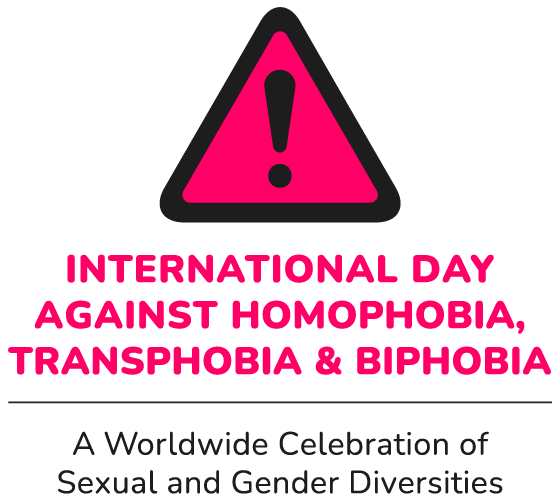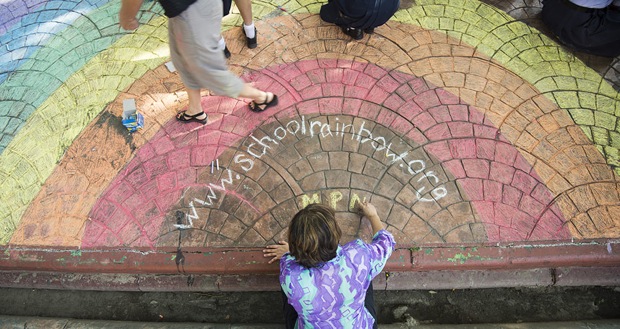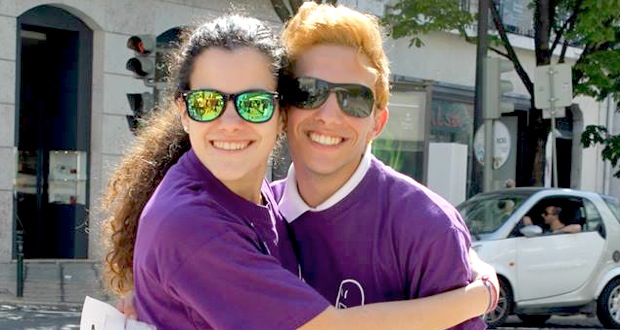Rainbow Chalk-ins or DIY Rainbow projects have grown massively in popularity over the past few years – from Sydney, to London, to Toronto and back to Bangkok, and beyond. They can make for visually impressive actions, which contest the exclusion of LGBTQI communities in public spaces, colour city streets, and get people involved in community arts along the way.
After Australian LGBTQI communities started taking matters into their own hands (after Sydney city authorities decided not to make their painted rainbow crossing a permanent feature of the city in 2013), the trend has grown and grown, with actions all over the world – many of which you can see in this gallery, put together by the DIY Rainbow project.

One of the most impactful of these actions for IDAHOT 2014 – both globally and locally – was the School Rainbow Campaign, in Bangkok, Thailand. Chalk-ins were organised in five schools on May 17, with the participation of young people, community organisations, school teachers and counsellors, and international agency staff. Thai national television and press reported on the actions, and photos of the actions were shared all over the world, in the week around IDAHOT. The campaign provided a way to publicise new lesson plans and information resources against LGBT bullying, and to open debate about discrimination within the schools and among the public in general.
Justine Sass from UNESCO, one of the organisations behind the scheme, told us more about how the campaign was organised – where the idea came from, what the team learned, and what advice they would give to others thinking about organising something similar…
How did the idea first come about?
So you may have seen that UNESCO and Plan International Thailand had done a study last year focused on the extent of homophobic and transphobic bullying in the country. It was the first systematic study of its kind – involving 30 schools and 2,000 students.
As we had the preliminary findings available and were starting to review them with stakeholders we were approached by staff from UNAIDS who were also starting some of their planning for IDAHOT. And we said look we’ve got this piece of data here for Thailand, and we would be really interested in what we could do beyond the launch of the research results. Because we knew that, you get this kind of data and it’s easy to engage some people, but it’s not easy to engage others. And so we wanted to do something that would bring the research into the media and would be an opportunity for us to have discussions in schools. And so that was where the idea originally was formed.

And so a number of different agencies and organisations came together. UNESCO, UNAIDS and then we wanted to bring some youth organisations on board, so we approached Youth Lead, which is an Asia-Pacific regional network working with young people from key populations. We also targeted Youth Voices Count which is again a regional network which is specifically targeting young MSM and young transgender people. And then APCOM which is the Asia-Pacific Male Coalition on Male Sexual Health. And YPC is actually a project of APCOM. So we had all these major organisations that were on board for the initiative.
As you can see, these are generally regional agencies which I will touch on later in terms of what I think are some of the lessons we learned. Because we didn’t have a local Thai partner that was directly involved in the initiative, although we had Thai programme staff that were assisting us with the planning. But it was one of the weaknesses I think in terms of the implementation of the initiative.
In terms of the timeline, it was about 3 months before IDAHOT that we started to do the planning, and that timeline was considered to be fairly tight, I would say.
What were the major risks/obstacles you faced, and how did you work around them?

We had two major risks. One was that the school year started the week that we were planning the activity. That was enormously difficult for us, in terms of outreach to school administrators and planning with relevant people in the schools. And we had to go through some fairly official processes, where the schools were requesting an invitation letter from UNESCO. And then they had to go through a process of discussion within their school management committees, but their school management committees weren’t convening yet. So really the most enormous hurdle for us was the timing of the Thai school year.
The other big planning issue for us was the rainy season, which doesn’t usually start in Thailand in May, but this year it started earlier than usual. And so when you’re planning an outdoor chalking campaign, you don’t want it to be washed away before anyone gets to see it. We were originally planning to do it in the evenings. So we were going to have students, teachers and this community of young people to do the chalking in the evening, with a ‘reveal’ moment the following morning, where the students would come into the school gates and they would see it, and would interact with it, and we would have further discussions.
It became clear, as the day was approaching, that it was raining every night. The original plan was to have it at the front gates in each school, but often we had to change that to look at places where there might be some sort of an overlay, or a sort of cover. We’d also looked at whether we should put tarps up before. But what we ended up doing was doing it on the morning of the ‘reveal’, so we actually got to the school at 6 o’clock in the morning – which had pros and cons.

In terms of cons, the major difficulty that we had was getting people to come and do it. So originally our community members were quite excited about doing the chalking in the evening, and were not happy about getting up there at 6 o’clock in the morning. So our teams got much smaller and we had to be much more creative about what we were doing.
I would say the major pro with that strategy was that it actually wasn’t finished. So we had students coming in that were able to engage with us, beyond the team that we had put together. So we could actually have a lot more conversations, because they would come and say, what are you doing? Can I help? And they would pick the colours and take part in the designing. And so I think it helped us to engage with many more students than we would have.
We did scoping visits to each of the sites first, together with a local NGO representative and the photographer, to see where might work best. And someone from the school was there for those visits. We were typically just looking for an arc, some sort of an arc around the school. In one of the schools it ended up being the school athletics track, and in another it was a roundabout. And each of them was a public location where we knew they would get a fair amount of traffic.
And then on the day itself, people just did take it the way that they wanted to. So there’s one for example, the last one that we did, which is a very fantastic – like in the very true sense of the word – like these fantasy drawings within each of the arcs. And that was the teachers and the local students and staff that had that idea, and just went with it. So we knew where we wanted to do it, and how it might look best, but the drawing itself was quite organic.
What did you learn from doing this action, what might you do differently?
I think this multi-partner planning process was really important, but I think there are also a couple of lessons that we could learn from it. One was the importance of having local youth organisations on board, to help with interactions on the day, and also because of the networks that they have – their capacity to share it with other organisations, and to help build the social media engagement that we wanted to get out of the campaign.

The other thing that we learned was the importance of having people in the schools that were really committed to taking it forward. In the schools that we did it in, that looked quite different. In the international school that we did it in, for example, it was the counsellor and that counsellor was really interested in taking it forward because she had LGBT students that were coming to her and were struggling and who didn’t feel like they were getting adequate support. So she really was committed to doing more. In some of the other schools it was the sex education teacher who was interacting with kids in sex education class, and was also realising that gender identity and sexual orientation were not adequately explored in the curriculum. And in some it was really the Principal, and that was really exciting for us, because it had that high-level senior engagement, of the school staff, and in and of itself, which was really important.
Did you originally plan to do a national-level campaign and how many schools did you plan to involve?
Originally we were looking at what we might do on a regional level, and we felt that with the timeline, and due to us being here in Thailand, and us having the data and having a real platform for discussion, that we wanted to start in Thailand, and then possibly do it in other countries as well. So we really focused on Thailand in particular. And in terms of the number of schools that we wanted to do it in, we didn’t have a fixed number. My original thinking on it (and I might have been in the minority) was that I wanted to do it in as many schools as possible. But the feeling was that there was a certain risk to that: if the school wasn’t adequately invested in supporting follow up, we shouldn’t be doing it, because we might be putting LGBT students, or those who are perceived to be, at risk of violence, which is exactly the thing that we were trying to avoid. And then we also had this problem with the start of the school year.

So in the end, the number of schools shrank considerably. And it’s a really critical question to ask: do you want to go to the ‘low-hanging fruit’, where there’s already interest in taking this forward – from the teachers and principals – or do you want to go to the more challenging settings? And I think because of the potential risks, we leaned more towards the ‘low-hanging fruit’, but with an advocacy strategy where we would try to reach out to the other schools through social media, through other media, and by making the lesson plans we’d developed available to any school that was interested in using them. And we looked at other media. We had our Director make a statement in the Bangkok Post, for example, around IDAHOT. And then we also did this call to action in the video. We created this video at the end, which said if any other schools are interested, please let us know and we will be happy to help you out you with materials and other types of support.
So out of that also came the social media activities that we did on facebook, on twitter, and the video that was done after IDAHOT which was done in English and Thai, and was also circulated through some of those same channels.
Watch the School Rainbow Campaign Video
How much would you say this sort of initiative might cost?
For the purchasing of the chalk, we probably put in around USD$800-1,000 in materials, and about half of that still remains [so, around $80-100 per school, for materials that were used]. Aside from that the main cost would have been around the production of the video and the translation of the materials. We also had a photographer that came on site over the course of the week to take photographs of the campaign.

All of the outreach, planning, social media and communications was integrated into our usual work, so it was relatively low cost I would say. But the social media part I think was really really important. We didn’t put any money into seeding – or when you try to raise the profile of your video or campaign on social media. I’m sure that that may have had an impact on the relatively low impact that we had on social media. UNAIDS estimates that through their channels they managed to reach about 850,000 people. I haven’t got the numbers on ours or on APCOM’s, but we were able reach a lot. But in terms of the likes and engagement that we got on youtube it was relatively low impact. And that could probably have been improved if we had put more money into the social media aspect.
The other thing I think, that is a lesson learned for us, is that the chalking in itself is one thing, and it’s great because you can have a dialogue with the people around it. But the follow up is really important. And so in the schools that we engaged with, there was a follow up in every school. And that looked different in every school, so in one it was an assembly, where the Principal spoke at that assembly, and so that reached all of the school – more than 1,000 kids in that school, and it was a fantastic demonstration of school commitment to the issue. In some of the other schools there were particular lessons that were introduced, or in one of the colleges there was a fantastic open plenary panel discussion, with an artistic performance that was part of it as well. But in each of them it wasn’t just the chalking that was done it was other things subsequent to it. And I think for us, we need to be able to go back to those schools in six months and ask, have you done anything else? Would you like us to offer support in doing something further? So that it’s not just about a one-off event, but about an ongoing commitment of the schools.
I think the team overall were really pleased with the impact of the campaign. It was picked up on Thai television, it was picked up in the Thai media, through other sources internationally as well which is really fantastic. And the thing is also for us is that the campaign enabled us to have other people looking into the research that we’d done. We really wanted also to have a discussion around the impact of homophobic bullying in educational institutions here, and I don’t think we would have gotten the attention to the issue that we got, without linking it to the campaign. So I think yes, we’re very pleased. We would like to do it in more schools, we’d like to do it in more locations, we’d like to see it in other countries as well. But I think that for what we were able to accomplish, with the financial investment we were able to make, within the timeline that we had, I think we got very good results.
What advice would you give to other people who might be considering organising something similar?

I think that one thing which is really important is the outreach to schools – just thinking about how you make the approach and to whom you make the approach. And that might look different in different settings, depending upon which partners are involved. Again as I say, we felt that having a champion within the school who would be involved beyond the chalking campaign itself was really important. The youth engagement as well, being able to say, if we do this in your school we would really need the following: at least one teacher who is involved, several students who could come and join us, some kind of follow up which could include assemblies, school lesson plans, etc.
Another thing we could also have done – we had stickers that we handed out that linked people to the website – is something else like a flyer or some sort of a handout. That could have been helpful. We could have reached more kids I think, and maybe gotten more interest in the website, and the resources that we have on it. And that could look different in different settings. It could be a hotline, or we could direct people to a specific organisation, or to a service.
The other thing is maybe to think more about working with other organisations that could help raise the social media aspect, to achieve more outreach beyond the communities that participated.
And another thing that was really important to us was to have some kind of broader call to action. So for us that was the video but it could be something else, that just mobilises people beyond those who participated.
Is there anything else you’d like to add?
Just that, thinking back, it would be great if there were some way of linking the schools together. So that people could learn about what was done in another location, and could share what they learned from it, as a way of taking it forward. That could be one thing that we didn’t explore as a possibility which could be really cool. Even just something as simple as having a one day celebration, further down the line, where you could bring people from each of the schools that participated and have a photo display or something, where they could talk about what they did. That might be interesting, and it might be a way to encourage other schools to participate.
Further Resources
- Find out more about the School Rainbow Campaign here.
- Download the research on LGBT bullying in Thailand, by UNESCO, Plan International and Mahidol University (Eng / Thai)
- Lesson plans on homophobia and transphobia, prepared for IDAHOT 2014, bu UNESCO (Eng / Thai)
- General resources on LGBT bullying, compiled as part of the School Rainbow Project
- Further resources (including lesson plans) on Fighting Homo/Transphobia in and through Education, by the IDAHO Committee
- DIY Rainbow campaign – facebook page
An interesting article on how this type of action becomes institutional: Transport for London rolls out Rainbow Crossings



